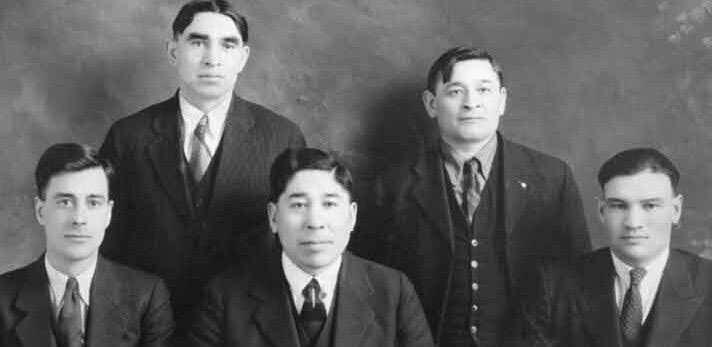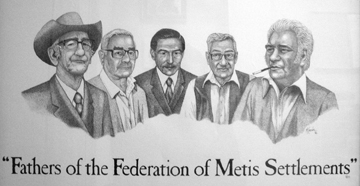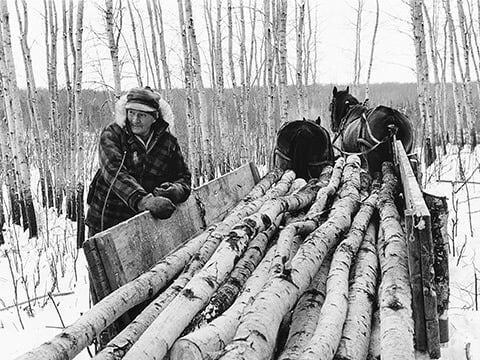OUR METIS SETTLEMENTS HISTORY
Metis Settlements in Alberta hold a special place in Canada as the only constitutionally recognized, land-based Metis recognized with 1.25 million acres of land protected and held in our stewardship (equal to the size of the entire province of Prince Edward Island).
During the 1930's, the Metis in Alberta wanted land set aside to protect their distinctive lifestyle. For the next half century there was a commitment to the vision: Our Land -- Our Culture -- Our Future.
In the 1990’s Alberta saw fit to entrench our Lands under the Alberta Constitution and – through legislation – they recognized and committed to our Settlement government that now serves thousands of our people across 8 Settlement communities.
We are the only Metis group that can lay claim to being recognized under existing provincial legislation and a Crown relationship that is backed by a constitutional amendment.
METIS HISTORY IN ALBERTA (PRE-1930s)
The history of the Settlements Metis in Alberta begins with the fur trade in North America.
From 1680 to 1821 the Metis populations grew regionally, typically around fur trading posts of the North-West and Hudson’s Bay companies. For example, Fort Edmonton spawned a large Metis population that was involved in an annual buffalo hunt for many years. These Metis helped to establish the settlements of Lac Ste. Anne (1844), St. Albert (1861), Lac La Biche (1853), and St. Paul de Metis (1890s).
The fur trade was an economic boom for the Metis as it opened the fur and buffalo meat trades to private Metis and non-Metis traders. However, it also exposed them to a flood of European and Canadian colonists seeking to profit and disenfranchise the Metis from their lands.
Following the uprisings, some Metis fled north-west, married to into the Northwest Metis populations of northern Alberta (formerly known as the District of Athabaska, North-West Territories) or assimilated into surrounding Euro-Canadian society.
The end of these uprisings combined with the collapse of the fur and buffalo meat industries forced many Alberta Metis off their lands and reduce them to critical levels of poverty.
Overall, the Metis cultures and communities survived with farming, ranching, fishing and industry replacing their traditional economy of fur-trading as the main economic activity, though trapping and hunting have remained very important.
More urban Metis who live in close proximity to other cultural groups may have intermarried and assimilated into mainstream Euro-Albertan society to the point that their descendants no longer recognize themselves as Metis.
However, in much of Northern Alberta, the Metis in more remote rural and isolated communities have remained culturally distinct.
THE BIG FIVE AND THE BIRTH OF THE SETTLEMENTS (1930s to 1960s)
Deplorable conditions, as a result of displacement and loss of economy, resulted in mass poverty for Metis people in northern Alberta.
In the early 1920s, the creation of l’Association des Metis d’Alberta et des Territoires du Nord-Ouest formed by the “Big Five” Metis leaders to lobby the government on behalf of our people.
The Big Five – Malcolm Norris, Felice Callihoo, Joseph Dion, James P. Brady, Peter Tompkins – went on to pressure government for a Royal Commission into the terrible conditions – and recommending that land be set aside for exclusive Metis use.

In December 1934, the Alberta government appointed a commission – the Ewing Commission, named after Judge Albert Freeman Ewing, the chair of the commission – to examine and report on Metis health, education, homelessness, and land issues.
By 1935, Commission hearings were being held across Alberta and Association President (Dion) and Vice President (Norris) consistently attended the Ewing Commission’s hearings and the deliberations. The final report of the Commission recommended that Alberta Metis should have land reservations for farming colonies (Settlements), homes, and schools.
Additionally, in recognition that the Metis were the original inhabitants of the proposed land allotments, the Commission acknowledged group rights and acknowledged that Settlement Metis should have preference over non-residents in harvesting, fish, fur, and game.
After organized political activism– like that organized by the Big Five – and the findings of the Ewing Commission, the passage of the 1938 Metis Population Betterment Act lands were set aside for Metis Settlement Associations.
When the province enacted the Metis Population Betterment Act, 12 Metis Settlements were created across Northern Alberta:
|
· Buffalo Lake |
· Cold Lake |
|
· East Prairie |
· Elizabeth |
|
· Fishing Lake |
· Gift Lake |
|
· Kikino |
· Marlboro |
|
· Paddle Prairie |
· Peavine |
|
· Touchwood |
· Wolf Lake |
Following this achievement, the Famous Five ceased operating via the Association, and the Association was inactive until the 1960s when it was unsuccessfully used to bring litigation against Alberta regarding an alleged breach of trust in allocating subsurface resource revenues.
During this period, four of the colonies, Touchwood, Marlboro, Cold Lake and Wolf Lake, were dissolved unilaterally by Alberta and their residents dispersed.
FATHERS OF THE FEDERATION (1960s to 1990s)
Although the Association was not itself active, the colonies pursued their interests and objectives through individual Settlement Associations.
In the 1970s, the Alberta Federation of Métis Settlements (the “Federation”) was formed by the “Fathers of the Federation” to further pursue the litigation against Alberta on a breach of trust claim.

The Fathers of the Federation - Adrian Hope, Maurice L’Hirondelle, Lawrence Desjarlais, Sam Johnston and Richard Poitras – were mandated to not only resolve the breach of trust claim, but also pursue three other priorities:
- secure the continued existence of Metis Settlement lands for future generations,
- gain greater control over the governance of those lands and their natural resources, and
- (achieve economic self-sufficiency.
In 1981, as part of the negotiations to resolve the litigation, and in anticipation of the coming into force of s. 35 of the Constitution Act, 1982, Alberta struck a Joint Métis-Government Committee (the “MacEwan Committee”) with the Federation to review the Metis Betterment Act and regulations.
The MacEwan Committee recommended that new legislation be passed to secure the land base for Métis and would also give Settlement Metis power to govern those lands. On June 3, 1985, the Alberta Legislative Assembly passed Resolution 18, which expressly endorsed the recommendations of the MacEwan Committee’s report.
On July 1, 1989, a historic document was signed be the Government of Alberta and Alberta Federation of Metis Settlements Associations. The Alberta-Settlements Accord proposed to bring local self-government to the Settlements and to provide the resources to bring the Settlements up to the economic level of other communities.
OSKIMÂCITÂHK: A NEW BEGINNING (1990s to 2010s)
The Federation realized its dream.
November 1, 1990, brought to a successful conclusion -- with the proclamation of the Accord legislation -- a struggle for recognition started in the first half of the 1900's and brought to fruition by former President Randy Hardy and the Settlement leaders of the day. The agreement between the Metis Settlements and the Provincial Government of Alberta marked the start of a new vision - and a new beginning.
The Accord legislation consisted of 6 documents:
- Letter Patent -- transferring the legal land title to the Settlements of the Settlement lands.
- Metis Settlements Land Protection Act
- Constitution of Alberta Amendment Act
- Metis Settlements Accord Implementation Act
- Metis Settlements Act
- Co-Management of Subsurface Resources Management
We now celebrate November 1 each year as “Proclamation Day” and we raise our flag along with the Government of Alberta at the Alberta Legislature.
On that day in 1990, the Alberta Federation of Metis Settlements became the Metis Settlements General Council (MSGC). That day also officially established the 8 Metis Settlements local governments we have today.
Our communities span a huge distance across northern Alberta – from as far north as Paddle Prairie Metis Settlement (8-hour drive north of Edmonton) to as far east as Fishing Lake Metis Settlement (4-hour drive north-east of Edmonton) at the Alberta/Saskatchewan border.
Our central pieces of legislation that detail our governance state the objective of the MSA and related legislation is to provide, under provincial law, for land-based self-government and to preserve and enhance Metis culture and identity.
The Supreme Court of Canada commented extensively on these aspects of the legislation in Alberta (Aboriginal Affairs and Northern Development) v. Cunningham, 2011 SCC 37. Cunningham recognizes the following principles:
- “The purpose and effect of the MSA is to enhance Métis identity, culture, and self-governance by creating a land base for Métis” (para. 3);
- “the preamble, wording, legislative history, and social context of the MSA combine to support the conclusion that the MSA is … a unique scheme that seeks to establish a Métis land base to preserve and enhance Métis identity, culture and self-government” (para. 69);
- The MSA “is the result of a negotiation process between the Métis of Alberta and the Province and the outcome of an ongoing struggle for self-preservation” (para. 66);
- The object of the MSA “is not the broad goal of benefitting all Alberta Métis… but the narrower goal of establishing a Métis land base to preserve and enhance Métis identity, culture and self-governance” (para. 62); and
- The “self-organization and standardization of the Métis community in Alberta is precisely what the Alberta legislature and the Alberta Métis have together sought to achieve in developing, agreeing upon and enacting the membership requirements found in the MSA” (para. 82)
OUR SETTLEMENTS TODAY (2010s to now)
In more recent years, the Metis Settlements General Council has continued in the tradition of our early leaders and has continued to advocate for the needs and interests of the Settlements and the membership.
In December 2018, the Honourable Carolyn Bennett, former Minister of Crown-Indigenous Relations, and Gerald Cunningham, former President of the Metis Settlements General Council, signed a Framework Agreement that outlined areas for discussion and continues to serves as the basis for negotiations of a reconciliation agreement with the eight Settlement councils and the Metis Settlements General Council. Areas for discussion outlined in the Framework include renewing the government-to-government relationship and supporting healthy, secure and prosperous communities by exploring priorities related to areas such as health, employment and skills development, housing, and child and family welfare.
The Metis Settlements General Council is continuing is work with the Government of Canada and is pursuing formal recognition with a Section 35 Rights Claim submission to the Crown in min-2024.

In March 2023, the Metis Settlements General Council also signed a renewed Protocol Agreement with the Government of Alberta. The Premier of Alberta, Danielle Smith, with President Dave Lamouche and Vice President Brenda Blyan, reaffirmed the shared commitment to work together to advance the long-term sustainability of the Settlements, and to achieve their social, economic, and cultural objectives.
OUR GOVERNANCE
Each of the 8 Settlements are governed by an elected Settlement Council of five – four Councillors and one Chairperson.
The members of the Settlement Councils then elect the 2 Executive – the President and Vice President – who represent the collective voices of the Settlements to coordinate, advocate and support outcomes for Settlement interests. The 40 locally elected Council members along with the 2 elected Executive members of the MSGC comprise the full Settlements Assembly as the central government – The Metis Settlements General Council (MSGC).
MSGC as a representative of the collective interest – was given the task of holding the fee simple title for all Settlement lands, creation of enabling policies, and passing laws applicable to all Settlements.
Settlements are responsible for managing all renewable and non-renewable resources, and passing bylaws applicable to their Settlement.
Additionally, Settlements – as governors of both people and of land – we are responsible for the care of those who live on the Settlements that we govern – including housing, infrastructure, water & sewer systems, waste management, land management, emergency & protective services, and other important duties of care.
Just as Canadian citizenship comes with responsibilities for both the citizen and the government, the same is true for the Metis Settlements General Council and our people across our Settlements.
Given the complexities of our unique position in Canada, in Alberta, and as we represent our Settlement members – MSGC remains deliberate in our actions and measured in our approach to advancing the interests of our Settlements and our membership.

